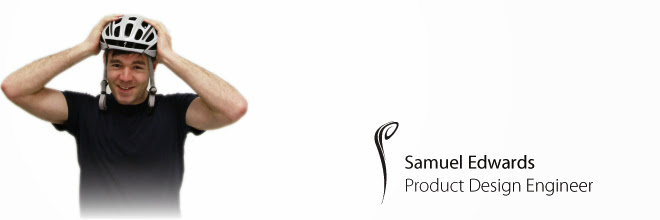The dimensions of the following prototypes all relate to money in some respect, be it the shape of a credit card, bank note, or implement the same ratio of length to width as a credit card or bank note. This is in an effort to create a subtle connection with money in producing a Chip and PIN device. I have also experimented with different profiles, concave and convex that work in a more natural swing of the thumb.
Wednesday 5 September 2012
Saturday 1 September 2012
Making of Mint Model
Having been asked some questions about how this model has been made, I have decided to share some of the details on its manufacturing process here!
Layered Ply:
First of all to generate a layered effect to mimic the layering of bank notes, several sheets of 12mm plywood were glued together and then turned into shape. Making two identical egg shapes on the lathe was very time consuming, especially given the hardness of the plywood, owing its high density to the composite of alternating direction of laminate sheet and the glue that holds everything together. To assist in generating identical shapes, a template of the profile was made.
Copper Inlay:
To create the effect of a coin edge, copper sheet has been inset into the model. Cutting this slot was carried out using a band saw that cut the exact thickness of copper sheet, 2mm. This meant that the sheet remained in place without need for additional gluing or fixing. Once trimmed to a rough size and shape, this was fitted and then finished to be flush with the surface and finally polished.
Base:
Using high density modeling foam, Ureal, the base is made from two parts to form a part line. This join represents the opening that electronic components would be housed in. The bases position each device at a shallow angle for easy access, vision and perceived security, the angle being carefully introduced by angled surfaces and a disc sander. In order to gain a flawless surface finish, smoothness is critical, achieved by sanding between primer and multiple paint layers. After paint and lacquer, color matched transfers are applied to represent the mint.com brand and make the product look more realistic.
Layered Ply:
First of all to generate a layered effect to mimic the layering of bank notes, several sheets of 12mm plywood were glued together and then turned into shape. Making two identical egg shapes on the lathe was very time consuming, especially given the hardness of the plywood, owing its high density to the composite of alternating direction of laminate sheet and the glue that holds everything together. To assist in generating identical shapes, a template of the profile was made.
Copper Inlay:
To create the effect of a coin edge, copper sheet has been inset into the model. Cutting this slot was carried out using a band saw that cut the exact thickness of copper sheet, 2mm. This meant that the sheet remained in place without need for additional gluing or fixing. Once trimmed to a rough size and shape, this was fitted and then finished to be flush with the surface and finally polished.
Base:
Using high density modeling foam, Ureal, the base is made from two parts to form a part line. This join represents the opening that electronic components would be housed in. The bases position each device at a shallow angle for easy access, vision and perceived security, the angle being carefully introduced by angled surfaces and a disc sander. In order to gain a flawless surface finish, smoothness is critical, achieved by sanding between primer and multiple paint layers. After paint and lacquer, color matched transfers are applied to represent the mint.com brand and make the product look more realistic.
Subscribe to:
Posts (Atom)












